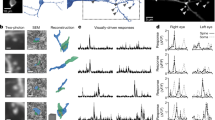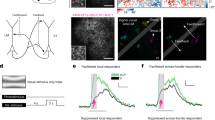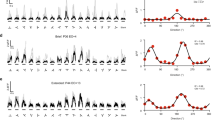Abstract
MOST neurones in the visual cortex of normal adult cats are binocular and respond very selectively to elongated contours of a particular orientation1. If a kitten is deprived of vision in one eye during a critical period in early life the afferents from this eye lose the ability to excite cortical cells2. This functional deafferentation is, however, reversible if, still within the critical period, the previously open eye is closed and the other opened3. These changes in afferent connectivity are attributed to competitive interactions between the pathways from the two eyes4,5, which have been shown to occur at the level of the striate cortex6. We previously demonstrated7 that afferents from the deprived eye remain functional when activity from the open eye is enhanced but fails to drive the common cortical target cell. This had suggested that the competitive suppression of one subset of converging afferents requires, in addition to imbalance in presynaptic activity, that the postsynaptic neurones actually respond to the more active pathways. Such postsynaptic gating was first postulated by Hebb8, and since then it has been assumed in most models on adaptive neuronal connections. In the study reported here more direct evidence for the participation of postsynaptic factors both in competitive suppression and in functional recovery of converging afferents was obtained. The results support Hebb's early hypotheses and demonstrate that both changes in connectivity are in fact guided by postsynaptic response properties.
This is a preview of subscription content, access via your institution
Access options
Subscribe to this journal
Receive 51 print issues and online access
$199.00 per year
only $3.90 per issue
Buy this article
- Purchase on Springer Link
- Instant access to full article PDF
Prices may be subject to local taxes which are calculated during checkout
Similar content being viewed by others
References
Hubel, D. H. & Wiesel, T. N. J. Neurophysiol. 160, 106–154 (1962).
Wiesel, T. N. & Hubel, D. H. J. Neurophysiol. 26, 1003–1017 (1963).
Blakemore, C. & Van Sluyters, R. C. J. Physiol., Lond. 237, 195–216 (1974).
Guillery, R. W. J. comp. Neurol. 144, 117–127 (1972).
Sherman, S. M., Guillery, R. W., Kaas, J. H. & Sanderson, K. S. J. comp. Neurol. 148, 1–18 (1976).
Cynader, M. & Mitchell, D. E. Nature 270, 177–178 (1977).
Singer, W., Rauschecker, J. P. & Werth, R. Brain Res. 134, 568–572 (1977).
Hebb, D. O. The Organization of Behaviour (Wiley, New York, 1949).
Freeman, R. D. & Pettigrew, J. Nature 246, 359–360 (1973).
Gruesser, O. J. & Gruesser-Cornehls, U. Pflügers Arch. ges. Physiol. 270, 227–238 (1960).
Singer, W. Expl. Brain Res. 50, 25–41 (1977).
Author information
Authors and Affiliations
Rights and permissions
About this article
Cite this article
RAUSCHECKER, J., SINGER, W. Changes in the circuitry of the kitten visual cortex are gated by postsynaptic activity. Nature 280, 58–60 (1979). https://doi.org/10.1038/280058a0
Received:
Accepted:
Issue Date:
DOI: https://doi.org/10.1038/280058a0
This article is cited by
-
Activity-dependent competition regulated by nonlinear interspike interaction in STDP: a model for visual cortical plasticity
Artificial Life and Robotics (2012)
-
Possible role of cooperative action of NMDA receptor and GABA function in developmental plasticity
Journal of Computational Neuroscience (2010)
-
The role of the feedforward paradigm in cognitive psychology
Cognitive Processing (2006)
-
Influence of experience on orientation maps in cat visual cortex
Nature Neuroscience (1999)
Comments
By submitting a comment you agree to abide by our Terms and Community Guidelines. If you find something abusive or that does not comply with our terms or guidelines please flag it as inappropriate.



